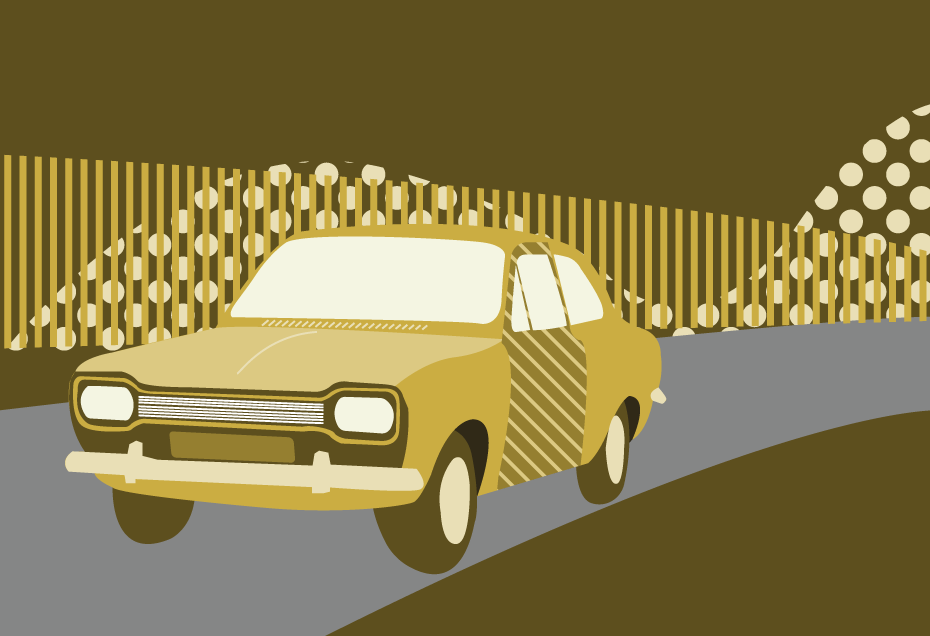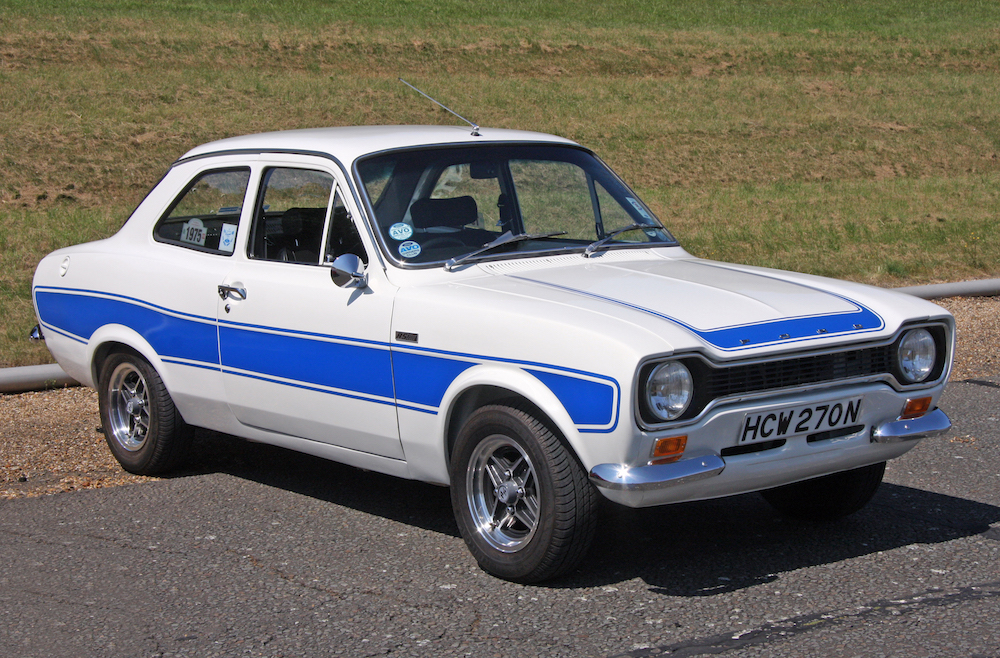The Ford Escort could be all things to all people – a trusty commuter trundler, a cheap family runabout, an ideal first car, or a souped-up pocket rocket.
Replacing the ageing Anglia in 1968, the Escort (cost new £679) proved an immediate sales success, despite lacking innovation, its gently curving shape pre-dating the “Coke-bottle” Cortina by two years.
But it was the sporty Escorts, with the twin launch in 1970 of the RS1600 and the legendary Mexico, that really caught the public’s imagination and marked the start of a triumphant hot blue oval dynasty.
We take a look at the principal sporting Escorts through the ages.
When it was launched in 1968, the Escort 1100cc Super propelled its occupants sedately to a top speed of 78mph, creeping from 0-60mph in 22.3 seconds – which was still a full seven seconds faster than the Anglia.
However, crucially for its sporting future, the car boasted exceptional poise on the road.
Autocar said of the basic model: “In its roadholding the Escort is in a different class altogether from the Anglia. It is the sort of car one can throw at a turn fast with supreme confidence (and) its crisp characteristics on the road will make it a car that drivers will like.”
And like it they did, with Ford announcing the 2-millionth Escort sold in the UK just six years after its launch, with 60 per cent of those cars built in Britain.
There were early sporty versions, with a tuned 1300GT, the Escort Sport featuring flared wheel arches, the 1300E with upmarket interior trim, and the 1557cc Twin Cam featuring an engine originally intended for the Lotus Elan.
The Twin Cam’s rally success laid the foundation stones for the RS1600, and the Escort went on to become one of the most successful rally cars of all time.
1970 Ford Escort RS1600
Considered the true genesis of the RS (Rallye Sport) breed, the RS1600 was the first product of Ford’s newly-created Advanced Vehicle Operations (AVO) plant.
Based at a special facility at the company’s Aveley Plant in south Essex, the AVO unit was created to build low volume, high performance versions of standard cars.
The first RS1600 was driven off the production line by F1 champion Graham Hill, and the car went on to dominate world rallying in the early 1970s, helping to make household names of drivers like Hannu Mikkola and Roger Clark.
Powered by a Cosworth, 1.6-litre engine – one of the first road-going cars to employ a four-valve-per-cylinder head – the body was strengthened by seam welding to cater for the stresses of competition.
CAR magazine questioned the RS1600’s credentials as an everyday car to be driven in town traffic, but had no doubts about the sheer fun factor of a small car that could reach 116mph and 0-60mph in just over 8 seconds.
“The RS1600 asks a lot of the driver and gives a lot in return. Above all it’s a drivers car and it’s performance is outstandingly good.
“(It’s) a pre-breakfast car in which to have enormous fun for short distances, before scurrying back to the garage while the law looks for you. As a sort of hairy, four-wheeled motorcycle the Escort is tremendous, but as an everyday car can prove too testy.”
But if you want to experience this ground-breaking car today you’d better have deep pockets, as mint examples can fetch from £30,000 to £60,000.
1970 Ford Escort Mexico
Not content with producing one sports Escort, the AVO unit launched the Mexico in December 1970 – a celebration of Mikkola’s car that won that year’s London to Mexico World Cup Rally.
Let’s face it, winning a race of 16,000 miles through some pretty gruelling terrain across Europe, South American and on into Central America is no mean advert for any car.
Based on the RS1600 bodyshell and suspension, the Mexico was powered by the tried-and-trusted Kent overhead-valve, 1.6-litre engine, and featured body stripes featuring the word “Mexico”, presumably so you knew what the car was from every angle.
Often painted in day-glo colours, the Mexico certainly looked the part, but in fact it was not as quick as people think they may remember, barely reaching 100mph and hitting 0-60mph in about 11 seconds.
But straight-line motorway speed was not what made the Mexico special: hit the B-roads and you’d find the car rode and handled like a dream, making rally drivers of the masses when there were rather fewer cars around to get in the way…
A good Mexico today will set you back at least £20,000, with some of the very best fetching nearer £50,000.
1973 Ford Escort RS2000
The third sporting kid on the block, slotting in between the Mexico and the RS1600, was 1973’s RS2000.
Its name may suggest an even quicker version of the Cosworth-powered RS1600, but the 2000 had more in common with the Mexico – a Cortina 2-litre “Pinto” engine producing 100bhp compared with the RS1600’s 115bhp.
But the car was much easier to drive than the more race-angled 1600, and it had significantly better low-down torque than its more tuned brother, allowing it to pull much stronger between 30-50mph and pull away smoothly without the need to keep the revs high.
Top speed touched 110mph, with 0-60mph achieved in 9 seconds – no slouch even by today’s standards and slap in between its two stablemates, which it also split in the price-lists at a shade over £1,500.
This proved the perfect combination for Ford customers, who wanted a practical, affordable, performance car; the RS2000 was the true forerunner of the hot hatches to follow.
In its original road test, Autocar said the car was more “refined” and “consistent” than its forerunners when driven hard.
“We make no secret of the fact that we find these high-performance Escorts tremendous fun cars and for the man who does not want the ultimate in competition machinery, the RS2000 makes a superb road car.
“On acceleration, top speed and cornering power it can hold its own with much more exotic models…and is really good value.”
More than 5,300 examples were made before the Mk2 hoved into view in 1975.
Like our illustration of the Ford Escort at the beginning of the article?
Download a free high-quality poster version here.
1975 Ford Escort RS1800
The boxy new mark II Escort arrived in showrooms early in 1975; in truth, it was little more than a rebodied mark I, but it was nevertheless as phenomenally successful as its forebear, both on the road and in competition.
The RS1800 was a rally special made in tiny numbers for the road (109 are believed to have been sold), with the rally car powered by a 2-litre fuel injected Cosworth belt-driven A series engine (BDA), and the road car using the less powerful twin-choke Weber feeding an 1800cc BDA unit
Imported from Germany following the fuel-crisis-driven closure of Ford’s Essex AVO, the RS1800 featured a heavily strengthened body, deep front spoiler and uprated brakes – whole Ford RS dealers could supply roll cages and fire extinguisher packages for those going weekend rallying.
The road car pushed out 115bhp, propelling the car to 111mph, with the Cosworth rally car potentially producing 240bhp. So how would this car fare on the road?
CAR magazine said: “The Escort RS1800 is not only perfectly acceptable as a very sporting everyday road car; indeed, it is a desirable one so long as one is seeking maximum fun per mile.”
As well as impeccable handling and that spirited engine, “what will surprise many people is its relative sophistication and comfort”.
Given the low numbers and those lost to rallying, a good RS1800 these days is likely to make more than £60,000 – indeed, a rolling body with no engine was recently offered for sale for £55,000…
The holy grail for collectors are the two red cars (all others came in diamond white), one press car and one road car…
1975 Ford Escort RS Mexico
The Mexico continued in mk2 guise where it had left off, with bright-coloured bodywork, a 1.6-litre OHC Pinto engine producing 95bhp and sprightly but not earth-shattering performance.
The Mexico gained the RS moniker, Recaro seats, split front bumpers, optional four-spoke alloys and a sports steering wheel.
Built in Saarlouis, West Germany, about 2,500 Mexicos were sold between 1975 and 1978, with prices today topping out at about £20,000.
1976 Ford Escort RS2000
The famous “droop snoot” RS2000 arrived in the year the even-more-famous Golf GTi was launched – the battle for supremacy in the small performance car market had been joined by the soon-to-be-dominant hot hatches.
But at the time the Golf was only available in imported, left hand drive form, so the Escort still reigned supreme as Britain’s favourite small-car-with-poke, for the time being at least.
That slanted, polyurethane nose combining twin headlamps and undercut by a front chin spoiler gave the hitherto boxy mark II a more aggressive outlook, while alloy wheels and a rubber boot spoiler completed the look.
The 2-litre SOHC four-cylinder engine produced 110bhp and, neatly, a top speed of 110mph, with 0-60mph achieved in around 9 seconds.
That’s no slouch by today’s standards, but if you consider that, at the time, it was only a shade slower than a Saab Turbo and on a par with a BMW 320i then you can see that the little Ford was punching well above its weight.
These days, prices are similar to that of the mark I RS2000, ranging from about £15,000 to up to £30,000 for the very best.
1980 Ford Escort XR3
The mark III Escort arrived in 1980 and, unlike the mark II, this was a totally new car from the ground up designed to compete with the VW Golf.
It used the same front wheel drive and transverse-mounted engine seen in the Fiesta, and in September 1980 the Escort joined the “hot hatch” battle that would dominate the motoring scene for a decade.
The XR3 proved an instant hit – smart, comfortable, modern and quick enough to go toe-to-toe with the Golf GTi of the day, it was a winning combination of practicality and performance, all with the built-in reliability of the Ford badge.
As ever with the Escort, roadholding was superb, and the Escort had more space for than the Golf, but fell down a little with excessive road noise and ride comfort.
The 1597cc engine produced 96bhp, propelling the car to a claimed 0-60mph in 9.2 seconds and on to 113mph, with 11,000 eager customers buying an XR3 in its first year of production.
The XR3 was identified by its tea-tray rubber boot spoiler, colour-coded body trim, sports interior, spot lamps and optional alloy wheels.
Testing the car in 1981 against the Golf GTi and Alfasud 1.5Ti, CAR magazine praised the XR3’s combination of performance and frugality (more than 32mpg).
Though the tester chose the Golf of the three overall, it had been in production much longer than the Ford: “…the Ford clearly has the most potential, a great deal of which is still to be realised.”
1980 Ford Escort RS1700T
The RS1700T was Ford’s great rally car that never was; a rear-wheel-drive, 1778cc Cosworth turbo-charged prototype that was scrapped after just 17 had been made.
It was supposed to succeed the mark II RS1800 and take the up and coming Group B World Rallying category by storm with its 350bhp unit (the road version was slated for 200bhp).
But a combination of development problems and the emergence of four-wheel-drive on the rally scene (the Audi Quattro et al) caused Ford to switch their attention to the all-wheel-drive RS200 (more of which later).
The car could reach 0-60mph in just 4.2 seconds on its way to 140mph, and many of the cars were privately rallied, with just five thought to survive today.
Adrian Flux Classic Car Insurance
A road test of this rarest of hot Escorts does exist, with the tester waxing lyrical about its on-road performance on his way back for the photograph session.
“…it seems there are a host of drivers ready to challenge the brutish looking little Ford with their refined imported cars.”
A Porsche 911SC roars off from the lights, clearly threatened by a car “right out of cheap street”.
“This time I put some enthusiasm into the pull off from the lights, the Porsche is no match, and still on a high I make my way to return the car to its owners.”
There’s no doubt the RS1700T could have been a rally winner, but the effort was not in vain, as many of the lessons learned in its development were put into the practice in the all-conquering RS200 that was to follow.
1982 Ford Escort RS1600i
The RS1600i was the XR3’s bigger, brasher, faster brother; a car built for racing and producing 115bhp in its road format.
It was distinguished from the XR3 by its deep front spoiler, seven-spoke alloys, biplane spoiler and lateral bonnet stripes, Recaro seats, power windows and remote locking.
The engine could be easily tuned to produce 160bhp, and this racecar for the road had stiffer suspension and heavy steering and was hard work to drive around town, only really happy out on the open road.
Built for the road purely to meet Group A homologation rules, only 8,659 examples were built and sold only through Rallye Sport dealers.
A product of the Ford Germany Motorsport project, the car was a sales success in Britain, and MotorSport magazine was impressed by the tuned engine.
“The RS1600i engine is very much sportier than its 115 bhp implies. Its sports camshaft really provides power between 4,000 and 6,500rpm.
“Acceleration is positively brilliant in the RS1600i, but on paper you will see little difference over the XR3i because of the rpm-limiter, which cancels much of the power unit’s extra sporting dash at high revs.”
An appreciating classic now, you may well have to pay up to £15,000 for a good one.
1983 Ford Escort XR3i
Despite its roaring success, the XR3 clearly needed to up its game if it was to be crowned king of the hot hatches – a hugely competitive market.
The development of the car was handed over to Ron Mansfield of Ford’s Special Vehicle Engineering division, and that’s when the XR3i came along to give the Escort some added oomph.
Built in Saarlouis, Germany, the car’s ride and handling were overhauled, and that all-important Bosch K-Jetronic fuel injection system was added, increasing power to 105bhp.
Top speed was now a very brisk 120mph, and 0-60mph could be reached in 8.5 seconds; the 1.8-litre Golf was still quicker to 60mph (8.2 seconds) but would trail the Ford by some distance at the top end (114mph).
What Car? pitted the XR3i against two more 80s hot hatch contenders in 1983, the Astra GTE and Fiat Strada 105TC; the Escort won hands down as the best sporting all-rounder.
“As the number of XR3s one sees on the road confirms, the car has a terrific showroom appeal, and really looks the part of a chic city racer, cleverly differentiated from the bread-and-butter Escort. It has excellent handling, and in everyday use it is practical and convenient.”
But it still wasn’t a Golf-beater (was anything?), with a less comfortable ride and comparatively unrefined engine than the German.
“In all the XR3i is the sensible road-going racer, taut and responsive and rewarding skilled driving with clean, quick handling.”
Along with the rest of the range, the XR3i received a facelift in 1986, along with a new engine producing 105bhp, and the XR badge lived on into the mid 1990s, when it was shelved seemingly never to return.
1984 – 1990 Ford Escort RS Turbo
Ford followed up the RS1600i by adding a Turbo in 1984, increasing the output from the same 1597cc CVH engine to 132bhp to produce an improved 0-60mph time of just 7.8 seconds.
Only 5,000 were planned for production for Group A homologation purposes, but this latest assault on the hot hatch crown proved so popular that 8,604 were made.
The car wasn’t just a souped up XR3; the suspension settings were altered, the engine’s compression ratio was lowered, and a viscous-coupling limited-slip differential helped to eliminate torque steer.
In a reverse echo of Henry Ford, you could have any colour as long as it was white (with added white spoilers and body kit over the XR3) – unless you were Lady Diana Spencer, who received the sole black mark 1 RS Turbo.
Test driving the car, MotorSport described the RS Turbo as “perhaps the most enjoyable hot hatch currently available on the British market”. Currently available, of course, because the new 16-valve Golf GTi was looming on the horizon…
The ride, a common complaint of the mark III Escort, again came under attack, however.
“An ideal driver’s car but all my passengers commented that the ride was uncomfortable on uneven surfaces. Even slight variations in the road surface brought complaints from the passenger seat, and I must say that my perception of the ride changed when I rode as a passenger.
“All in all, however, the RS Turbo is a well-engineered, tight, package which will doubtless fulfil Ford’s hopes on race circuits while giving private owners a distinctive sporting car, albeit one which is not particularly cheap nor economical.”
As for prices, you can find a good car for between £15,000 and £20,000, although prices are rising.
In November 2015, an RS Turbo with only 5,568 miles on the clock was sold for a world-record £60,188 at Silverstone Auctions.
The series 2 RS Turbo was launched in 1986, this time more aimed at the road user rather than built solely for homologation purposes.
Performance was very similar to the earlier car, with a top speed of 125mph, the only changes to the engine being a water-cooled Garrett turbo, longer gearing, revised cylinder head and new piston, plus improvements to the Jetronic unit and Intercooler.
You could, however, now have your RS Turbo in red, black, and metallic grey, as well as the only previous choice, white.
Testing the car in 1986, Autocar said Ford had succeeded in building a quick, practical hatch: “…this is a slightly more civilised hot hatch, better adapted to fast, long-distance motoring in improved comfort than its predecessor.”
However, that’s not necessarily what those of a sportier bent really hanker after in their RS Turbo. Autocar’s tester concludes that the RS had slightly lost its edge compared to its first rally-bred incarnation: “Anyone who drove the original…is likely to be disappointed by this second, slightly softer, version.”
1984 Ford RS200
Not really an Escort at all, the RS200 was the result of Ford’s determination to build a rally car to compete with the 4WD Audi Quattro, Peugeot 205 T16 and Lancia Delta on the helter skelter Group B rally circuit.
After the failure of the RS1700T, an entirely new approach was called for.
Designed by Ghia, the body was built by none other than fibreglass specialists Reliant, famous for the Robin but also the sporty Scimitar, with F1 gurus Tony Southgate and John Wheeler taking care of the chassis.
The mid-mounted, turbo-charged, 1.8-litre Cosworth engine reportedly threw out 450bhp in race trim, resulting in some truly startling performance figures: 0-60mph in under four seconds and a top speed pushing 140mph.
Sadly, the RS200 was never to reach its rallying potential as the FIA abolished Group B racing following a number of fatal accidents, including two involving the ill-fated Ford.
In the 1986 Rally de Portugal, an RS200 was involved in one of the most catastrophic World Rally Championships accidents of all time, with the death of three spectators and many others injured. Audi pulled out of Group B immediately, and the deaths of Henri Toivonen and co-driver Sergio Cresto in a Lancia, and Marc Surer’s co-driver Michel Wyder in an RS200 sealed the competition’s fate.
It’s thought that only 90 of the 200 road cars originally built for Group B homologation purposes were sold for the road, and the How Many Left website shows just 33 of those remain in the UK.
The road car’s engine produced 250bhp, though a 350bhp “rally spec” upgrade was available, which reportedly propelled this beast of a car to a supercar-matching 180mph.
Indeed, when CAR magazine got hold of an RS200 for testing in 1985, Georg Kacher wrote: “In terms of handling and traction, this plastic bombshell must eat a Testarossa or a 911 Turbo for breakfast.”
Tragedy, however, ensured the car never achieved its full potential, on road or track.
Like our illustration of the Ford Escort at the beginning of the article?
Download a free high-quality poster version here.
1991 Ford Escort RS2000
The mk5 appeared in 1990 with all-new bodyshell, and a year later a new RS2000 was unveiled, with a 2-litre engine from the Sierra, upgraded with a new 16-valve head and producing 150bhp.
It was differentiated from the slightly disappointing standard car by subtle bonnet bulges, deeper front bumper, a small rear spoiler, and alloy wheels, while the suspension was stiffened and the previously drab interior was boosted by Recaro seats and white dials.
The RS2000 featured improved handling, a top speed of 133mph and a respectable 8.4 seconds (though this was barely faster than the 1983 XR3i), while it performed well in rallying, taking the 1996 British Rally Championship.
A four-wheel-drive version was available from 1992, which offered more grip but at the expense of pulling power.
Writing in the Independent, John Simister somewhat damned the car with feint praise: “These latest RS2000s are competent enough, but they don’t really excite. Trouble is, that applies to many of today’s sporty hatchbacks, which partly explains why insurance companies no longer hate them.”
Clarkson held a similar view here; good but not great.
The RS2000 ceased production in 1996, the last Escort ever to wear the famous RS badge.
1992 Ford Escort RS Cosworth
The legendary “Cossie” was a classic from the moment it was born out of Ford’s desire to win the World Rally Championship.
That aim wasn’t successful, but it did win eight Group A events between 1993 and 1996, and proved so desirable as a road car that Ford carried on making them long after the initial 2,500 cars were sold for homologation purposes.
In truth, the RS Cosworth was an Escort in body-shape only – it was based on the chassis and mechanicals of its predecessor, the Sierra Cosworth, with mk 5 Escort panels bolted on.
Built by Karmann in Germany, the Cossie featured the same 2-litre, turbocharged engine as the Sierra under the bonnet, and that spectacular and instantly recognisable “whale tail” rear spoiler.
Power was delivered through all four wheels, peaking at 227bhp at 6,250rpm, producing a top speed in the region of 145mph and 0-60mph in 6.1 seconds – comfortably out-performing the Golf GTi and reaching up into BMW M3 territory.
Two models were available at launch, a standard car at £21,380 and the Lux version with electric windows, heated screen etc at more than £23,000 – expensive given the new, 165mph Focus RS costs under £30,000 nearly 25 years later…
The first 2,500 cars were pure road-going Group A rally racers for homologation, and suffered from turbo lag, before Ford fitted a smaller Garrett Turbo for the remainder of the production run. The “whale tail” was an optional extra on the later cars, though most customers opted in.
Motor Sport magazine tested the Cosworth at launch, and while it was suitably impressed, it raised doubts about the car’s road-going viability, which ultimately proved unfounded.
“Of course the RS Cosworth is quick, when roused, but it is also very civil at legal speeds. Twirl that unlovable steering wheel with determination, and the Escort RS rewards you with unparalleled cross-country speed,” the magazine said.
“The sheer grip is a class beyond even the Lancia Delta Integrale, while (the) Cosworth will skim through a series of 137mph autobahn curves at a constant 6116 rpm in fifth with a security and accuracy that is unmatched in our road car experience.”
However, thefts of hot hatches had become a serious concern for insurers, and Motor Sport warned: “Although Ford is promising high levels of anti-theft protection with an engine immobilisation added to the double lock doors and alarm, the insurance companies have decided that Cosworths, especially in an even higher performance Escort version, are economically uninsurable. Quotes from £1200-£3000 are now common. Ford will do well to sell the modest UK plan of 700 to 750 of the necessary 2,500 winged wonders needed for Jan 1, 1993 homologation and the planned Monte Carlo Rally debut.”
They did, and went on to sell 7,145 vehicles in total.
According to howmanyleft there are 1,227 cars left in the UK, with prices ranging from £15,000 to £60,000 for the very best. Our latest car extinction report predicts that the Ford Escort could be extinct by 2023!
1997 Ford Escort GTi
A footnote included here purely because it was the only GTi-badged Ford to ever be sold in Europe, the Ford Escort GTi was introduced in 1997, featuring a pretty standard 1.8-litre Zetec engine producing 115PS, and clothed in a body kit left over from the out of production RS2000.
There was even a GTi estate, and in truth the GTi was little more than a bid to maximise Escort sales in its last days before the Focus arrived.
The Escort era may be well and truly over, but its replacement has more than carried on the RS torch, with the new, third generation Focus RS hitting 62mph in 4.7 seconds. The future of the fast Ford is in very good hands.
Adrian Flux was one of the only UK insurance brokers able to provide affordable cover for hot hatches throughout the 1980s and 1990s, and still offers competitive rates for these cars today, many of which can be covered on classic car policies, with agreed value, and limited mileage discounts.
There are also discounts available for members of owners clubs.
Get a quote for your sporting Escort or hot hatch – request a call back because our best rates are available on the phone.






















